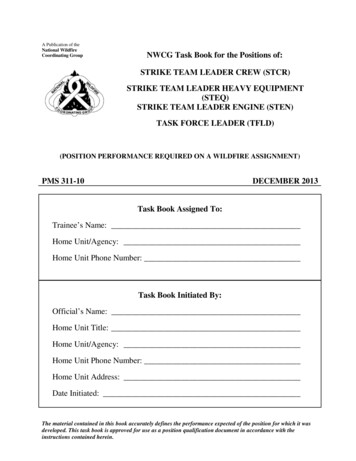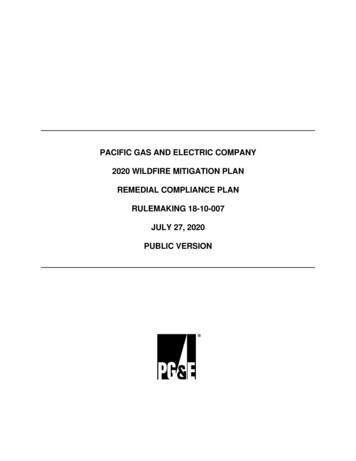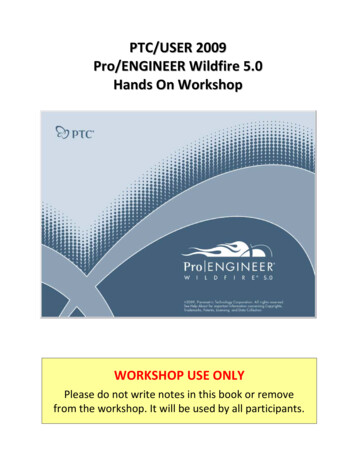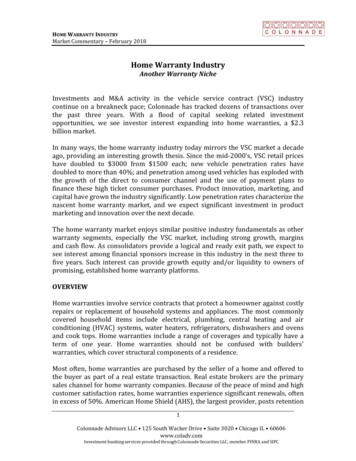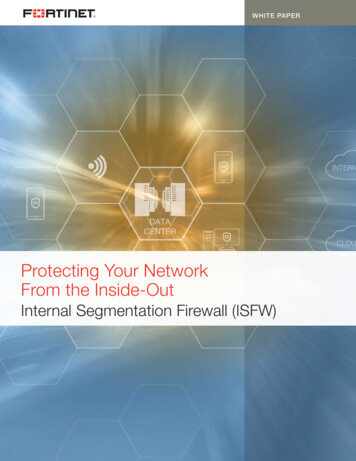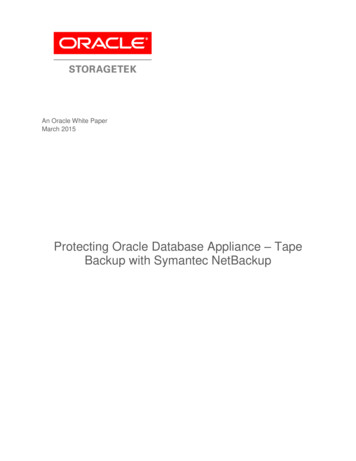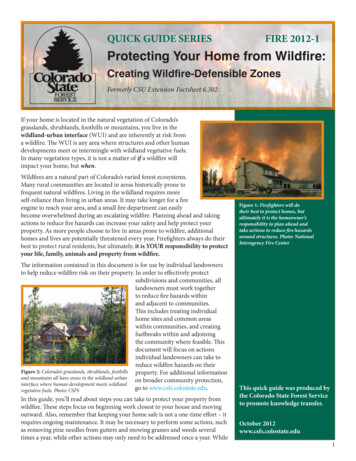
Transcription
QUICK GUIDE SERIESFIRE 2012-1Protecting Your Home from Wildfire:Creating Wildfire-Defensible ZonesFormerly CSU Extension Factsheet 6.302If your home is located in the natural vegetation of Colorado’sgrasslands, shrublands, foothills or mountains, you live in thewildland-urban interface (WUI) and are inherently at risk froma wildfire. The WUI is any area where structures and other humandevelopments meet or intermingle with wildland vegetative fuels.In many vegetation types, it is not a matter of if a wildfire willimpact your home, but when.Wildfires are a natural part of Colorado’s varied forest ecosystems.Many rural communities are located in areas historically prone tofrequent natural wildfires. Living in the wildland requires moreself-reliance than living in urban areas. It may take longer for a fireengine to reach your area, and a small fire department can easilybecome overwhelmed during an escalating wildfire. Planning ahead and takingactions to reduce fire hazards can increase your safety and help protect yourproperty. As more people choose to live in areas prone to wildfire, additionalhomes and lives are potentially threatened every year. Firefighters always do theirbest to protect rural residents, but ultimately, it is YOUR responsibility to protectyour life, family, animals and property from wildfire.The information contained in this document is for use by individual landownersto help reduce wildfire risk on their property. In order to effectively protectsubdivisions and communities, alllandowners must work togetherto reduce fire hazards withinand adjacent to communities.This includes treating individualhome sites and common areaswithin communities, and creatingfuelbreaks within and adjoiningthe community where feasible. Thisdocument will focus on actionsindividual landowners can take toreduce wildfire hazards on theirFigure 2: Colorado’s grasslands, shrublands, foothills property. For additional informationand mountains all have areas in the wildland-urbanon broader community protection,interface where human development meets wildlandgo to www.csfs.colostate.edu.vegetative fuels. Photo: CSFSIn this guide, you’ll read about steps you can take to protect your property fromwildfire. These steps focus on beginning work closest to your house and movingoutward. Also, remember that keeping your home safe is not a one-time effort – itrequires ongoing maintenance. It may be necessary to perform some actions, suchas removing pine needles from gutters and mowing grasses and weeds severaltimes a year, while other actions may only need to be addressed once a year. WhileFigure 1: Firefighters will dotheir best to protect homes, butultimately it is the homeowner’sresponsibility to plan ahead andtake actions to reduce fire hazardsaround structures. Photo: NationalInteragency Fire CenterThis quick guide was produced bythe Colorado State Forest Serviceto promote knowledge transfer.October 2012www.csfs.colostate.edu1
you may not be able to accomplish ALL of the actions described in this documentto prepare your home for wildfire, each completed activity will increase the safetyof your home, and possibly your family, during a wildfire.(Note: These guidelines are adapted for ponderosa pine, Douglasfir and mixed-conifer ecosystems below 9,500 feet. See page 9 forguidelines adapted to other forest ecosystems.)This guide primarily will help design your defensible space.Defensible space is the natural and landscaped area around ahome or other structure that has been modified to reduce firehazard. Defensible space gives your home a fighting chanceagainst an approaching wildfire. Creating defensible spacealso reduces the chance of a structure fire spreading to thesurrounding forest and other homes.Figure 3: Burning embers can be carriedlong distances by wind. Embers ignitestructures when they land in gaps,crevices and other combustible placesaround the home. Photo: CSFSRemember. Reducing fuels arounda home will increasethe chances forsurvival in a wildfire,but there is noguarantee. This quick guideprovides minimumguidelines. The morefuels you remove, thegreater the chanceyour home will survive. Working withyour neighborsand communitywill increase theeffectiveness of yourhome’s defensiblespace.Three factors determine wildfire behavior: fuels, weather andtopography. We cannot alter weather or topography, so wemust concentrate on altering fuels. Fuels include vegetation,such as trees, brush and grass; near homes, fuels also includesuch things as propane tanks, wood piles, sheds and even homes themselves.Some plant species are more flammable than others, and the flammability ofvegetative fuels changes depending on the season, recent weather events, andother factors such as drought. Fuel continuity and density also play an importantrole in wildfire.Wildfire often creates its own weather conditions. Hot rising air and associatedwinds can carry embers and other burning materials into the atmosphere for longdistances, where they can ignite vegetation and structures up to several milesaway. Embers have caused the loss of many homes during wildfires.As you think about protecting your home and property from wildfire, considerhow you can manage fuels on your property to prevent fire from spreading toyour home and other structures.For more information on wildfire behavior, please see FireWise Construction: SiteDesign and Building Materials at www.csfs.colostate.edu.Fuel Arrangement and TypesWhen fuels are abundant, a fire can be uncontrollable and destructive. But whenfuels are scarce, a fire cannot build momentum and intensity, which makes itmuch easier to control and is more likely to be beneficial to the land.The more dense and continuous the fuels, the bigger the threat they pose to yourhome. The measure of fuel hazard refers to its continuity, both horizontal andvertical. Horizontal continuity refers to fuels across the ground, while verticalcontinuity refers to fuels extending from the ground up into the crowns of treesand shrubs. Fuels with a high degree of both vertical and horizontal continuityare the most hazardous, particularly when they occur on slopes. Mitigation ofwildfire hazards focuses on breaking up the continuity of horizontal and verticalfuels.Heavier fuels, such as brush and trees, produce a more intense fire than light fuels,such as grass. However, grass-fueled fires travel much faster than heavy-fueledfires. Some heavier surface fuels, such as logs and wood chips, are potentiallyhazardous heavy fuels and also should be addressed.2
Vertical/Ladder FuelsLadder fuels are defined as smaller trees and brush that provide vertical continuity, whichallows a fire to burn from the ground level up into the branches and crowns of larger trees.Lower branches on large trees also can act as ladder fuels. These fuels are potentially veryhazardous, but are easy to mitigate. The hazards from ladder fuels near homes are especiallyimportant to address. Prune all tree branches from ground level up to a height of 10 feetabove ground or up to 1/3 the height of the tree, whichever is less. Do not prune furtherup because it could jeopardize the health of the tree. Shrubs should be pruned based onspecifications recommended for the species. Dead branches should be removed wheneverpossible.Surface FuelsLogs/Branches/Slash/Wood ChipsNaturally occurring woody material on the ground and debris from cutting down trees(also known as slash) may increase the intensity of fires. Increased fire intensity makes afire harder to control and increases the likelihood of surface fires transitioning to crownfires. Dispose of any heavy accumulation of logs, branches and slash by chipping, haulingto a disposal site or piling for burning later. Always contact your county sheriff ’s office orlocal fire department first for information about burning slash piles. Another alternative isto lop and scatter slash by cutting it into very small pieces and distributing it widely overthe ground. If chipping logs and/or slash, it’s essential to avoid creating continuous areasof wood chips on the ground. Break up the layer of wood chips by adding nonflammablematerial, or allow for wide gaps (at least 3 feet) between chip accumulations. Also, avoidheavy accumulation of slash by spreading it closer to the ground to speed decomposition. Ifdesired, two or three small, widely spaced brush piles may be left for wildlife habitat. Locatethese well away from your home (NOT in Zones 1 or 2; see page 5-8 for zone descriptions).Figure 4: Ladder fuels are shrubsand low branches that allow awildfire to climb from the groundinto the tree canopy. Photo: CSFSFigure 5: Surface fuels include logs,branches, wood chips, pine needles,duff and grasses. Photo: CSFSPine Needles/Duff LayersDue to decades of fire suppression, decomposing layers of pine needles, twigs and other organic debris–called duff – isdeeper under many large trees today than it would have been a century ago. This is especially true in ponderosa pine forestswhere frequent and naturally occurring fires have been absent. These large trees often are lost when fires occur, becauseflames burning in the duff layer can pre-heat live vegetation and ignite the trees, or the tree’s roots can be damaged from theintense heat of the smoldering duff, killing the tree. It is important to rake needle or dufflayers deeper than 2 inches at least 3 feet away from the base of large trees. This should bedone annually, and the additional duff also should be removed from the area.GrassesGrasses are perhaps the most pervasive and abundant surface fuel in Colorado. Mow grassesand weeds as often as needed throughout the growing season to keep them shorter than 6inches. This applies to irrigated lawns and wild or native grasses. This is critical in the fall,when grasses dry out, and in the spring, after the snow is gone but before plants green-up.Be especially careful when mowing in areas with rocks. Mower blades can hit rocks andcreate sparks, causing fires in dry grass. Consider mowing only on days with high humidityor after recent moisture to reduce the risk of starting an unwanted fire.Figure 6: Tree canopies offer fuelfor intense crown fires. Photo: PaulMintierWhen mowing around trees, be sure to avoid damaging the root system and tree trunk byusing a higher blade setting on the mower and trimming grass that grows against the trunk only by hand.Crown FuelsAn intense fire burning in surface fuels can transition into the upper portion of the tree canopies and become a crownfire. Crown fires are dangerous because they are very intense and can burn large areas. Crown fire hazard can be reducedby thinning trees to decrease crown fuels, reducing surface fuels under the remaining trees, and eliminating vertical fuelcontinuity from the surface into the crowns. Specific recommendations are provided in the Defensible Space ManagementZones, pages 5-8.3
The Home Ignition ZoneStructure IgnitabilityDefensible SpaceThe Home Ignition ZoneFigure 7: Addressing both componentsof the Home Ignition Zone will providethe best protection for your home.Credit: CSFSFigure 8: (above)Wood shingleroofs are highlyflammable andnot recommended.Photo: CSFSFigure 9: (above right) Class A roofingmaterials including tile, clay, concrete,slate and asphalt shingles are fireresistant options. Photo: CSFSTwo factors have emerged as the primary determinants of a home’sability to survive a wildfire – the quality of the defensible space anda structure’s ignitability. Together, these two factors create a conceptcalled the Home Ignition Zone (HIZ), which includes the structureand the space immediately surrounding the structure. To protect ahome from wildfire, the primary goal is to reduce or eliminate fuels andignition sources within the HIZ.Structural IgnitabilityThe ideal time to address home ignition risk is when the structure isin the design phase. However, you can still take steps to reduce ignitability to anexisting home.The roof has a significant impact on a structure’s ignitability because of itsextensive surface area. When your roof needs significant repairs or replacement,use only fire-resistant roofing materials. Also, check with your county buildingdepartment – some counties now have restrictions against using wood shinglesfor roof replacement or require specific classifications of roofing material. Woodand shake-shingle roofs are discouraged because they are highly flammable,and are prohibited in some areas of the state. Asphalt shingles, metal sheets andshingles, tile, clay tile, concrete and slate shingles are all recommendedroofing materials.The extension of the roof beyond the exterior structure wall is theeave. This architectural feature is particularly prone to ignition. As fireapproaches the building, the exterior wall deflects hot air and gassesup into the eave. If the exterior wall isn’t ignition-resistant, this effect isamplified.Most decks are highly combustible. Their shape traps hot gasses,making them the ultimate heat traps. Conventional wooden decks are socombustible that when a wildfire approaches, the deck often ignites before the firereaches the house.The exterior walls of a home or other structure are affected most by radiant heatfrom the fire and, if defensible space is not adequate, by direct contact with flamesfrom the fire.Windows are one of the weakest parts of a building with regard to wildfire.They usually fail before the building ignites, providing a direct path forflames and airborne embers to reach the building’s interior.Burning embers are produced when trees and structures are consumed bywildfire. These embers sometimes can travel more than a mile. Flammablehorizontal or nearly horizontal surfaces, such as wooden decks or shakeshingle roofs, are especially at risk for ignition from burning embers. Sinceairborne embers have caused the loss of many homes in the WUI, addressingstructural ignitability is critical, even if the area surrounding a home is notconducive to fire spread.Figure 10: Decks, exterior walls andwindows are important areas toexamine when addressing structureignitability. Photo: CSFSThis guide provides only basic information about structural ignitability. Formore information on fire-resistant building designs and materials, refer to theCSFS FireWise Construction: Site Design and Building Materials publication atwww.csfs.colostate.edu.4
Defensible SpaceDefensible space is the area around a home or other structurethat has been modified to reduce fire hazard. In this area,natural and manmade fuels are treated, cleared or reducedto slow the spread of wildfire. Creating defensible space alsoworks in the reverse, and reduces the chance of a structure firespreading to neighboring homes or the surrounding forest.Defensible space gives your home a fighting chance against anapproaching wildfire.Creating an effective defensible space involves a series ofmanagement zones in which different treatment techniquesare used. Develop these zones around each building on yourproperty, including detached garages, storage buildings, barnsand other structures.Figure 11: Homesite before defensiblespace. Photo: CSFSThe actual design and development of your defensible space depends on severalfactors: size and shape of building(s), construction materials, slope of the ground,surrounding topography, and sizes and types of vegetation onyour property. You may want to request additional guidancefrom your local Colorado State Forest Service forester, firedepartment or a consulting forester as you plan a defensiblespace for your property.Defensible space provides another important advantage during afire: increased firefighter safety. Firefighters are trained to protectstructures only when the situation is relatively safe for them todo so. They use a process called “structural triage” to determineif it is safe to defend a home from an approaching wildfire. Thepresence or absence of defensible space around a structure isa significant determining factor used in the structural triageprocess, as defensible space gives firefighters an opportunity todo their job more safely. In turn, this increases their ability to protect your home.Figure 12: Homesite after creating adefensible space. Photo: CSFSIf firefighters are unable to directly protect your home during a wildfire, havingan effective defensible space will still increase your home’s chance of survival. Itis important to remember that with wildfire, there are no guarantees. Creatinga proper defensible space does not mean that yourhome is guaranteed to survive a wildfire, but it doessignificantly improve the odds.Zone 1Defensible SpaceManagement Zones0-15/30feetZone 2Zone 330-100feet100 feetThree zones need to be addressed when creatingdefensible space:Zone 1 is the area nearest the home and otherstructures. This zone requires maximum hazardreduction.Zone 2 is a transitional area of fuels reductionbetween Zones 1 and 3.Zone 3 is the area farthest from the home. It extendsfrom the edge of Zone 2 to your property boundaries.Defensible Space ZonesFigure 13: Defensible space managementzones. Credit: CSFS5
Zone 1The width of Zone 1 extends a minimum distance of 15-30 feet outward from astructure, depending on property size. Most flammable vegetation is removed inthis zone, with the possible exception of a few low-growing shrubs or fire-resistantplants. Avoid landscaping with common ground junipers, which are highlyflammable.Figure 14: This homeowner workedhard to create a defensible space aroundthe home. Notice that all fuel hasbeen removed within the first 5 feet ofthe home, which survived the WaldoCanyon Fire in the summer of 2012.Photo: Christina Randall, ColoradoSprings Fire DepartmentFigure 15: Clearing pine needles andother debris from the roof and gutters isan easy task that should be done at leastonce a year. Photo: CSFSIncreasing the width of Zone 1 will increase the structure’s survivability. Thisdistance should be increased 5 feet or more in areas downhill from a structure.The distance should be measured from the outside edge of the home’s eavesand any attached structures, such as decks. Several specific treatments arerecommended within this zone: Install nonflammable ground cover and plant nothing within the first 5 feetof the house and deck. This critical step will help prevent flames from cominginto direct contact with the structure. This is particularly important if abuilding is sided with wood, logs or other flammable materials. Decorativerock creates an attractive, easily maintained, nonflammable ground cover. If a structure has noncombustible siding (i.e., stucco, synthetic stucco,concrete, stone or brick), widely spaced foundation plantings of low-growingshrubs or other fire-resistant plant materials are acceptable. However, do notplant directly under windows or next to foundation vents, and be sure areas ofcontinuous grass are not adjacent to plantings. Information on fire-resistantplants is available on the CSFS website at www.csfs.colostate.edu. Prune and maintain any plants in Zone 1 to prevent excessive growth. Also,remove all dead branches, stems and leaves within and below the plant. Irrigate grass and other vegetation during the growing season. Also, keep wildgrasses mowed to a height of 6 inches or less. Do not store firewood or other combustible materials anywhere in this zone.Keep firewood at least 30 feet away from structures, and uphill if possible. Enclose or screen decks with 1/8-inch or smaller metal mesh screening(1/16-inch mesh is preferable). Do not use areas under decks for storage. Ideally, remove all trees from Zone 1 to reduce fire hazards. The more treesyou remove, the safer your home will be. If you do keep any trees in this zone, consider them part of the structure andextend the distance of the entire defensible space accordingly. Remove any branches that overhang or touch the roof, and remove all fuelswithin 10 feet of the chimney. Remove all pine needles and other debris from the roof, deck and gutters. Rake pine needles and other organic debris at least 10 feet away from all decksand structures. Remove slash, wood chips and other woody debris from Zone 1.Zone 2Figure 16: Enclosing decks with metalscreens can prevent embers fromigniting a house. Photo: MarilynBrown, La Plata CountyZone 2 is an area of fuels reduction designed to diminish the intensity of a fireapproaching your home. The width of Zone 2 depends on the slope of the groundwhere the structure is built. Typically, the defensible space in Zone 2 shouldextend at least 100 feet from all structures. If this distance stretches beyond yourproperty lines, try to work with the adjoining property owners to complete anappropriate defensible space.6
The following actions help reduce continuous fuels surrounding a structure, while enhancing home safety and the aestheticsof the property. They also will provide a safer environment for firefighters to protect your home.Tree Thinning and Pruning Remove stressed, diseased, dead or dying trees and shrubs.This reduces the amount of vegetation available to burn, andmakes the forest healthier.10-footspacingbetween treecrownsTreeCrown Remove enough trees and large shrubs to create at least 10feet between crowns. Crown separation is measured from theoutermost branch of one tree to the nearest branch on thenext tree. On steep slopes, increase the distance between treecrowns even more. Remove all ladder fuels from under remaining trees. Prune treebranches off the trunk to a height of 10 feet from the groundFigure 17: In Zone 2, make sure there is at least a 10-foot spacingor 1/3 the height of the tree, whichever is less.between tree crowns. Credit: CSFS If your driveway extends more than 100 feet from your home, thin out trees within a 30 foot buffer along both sides ofyour driveway, all the way to the main access road. Again, thin all trees to create 10-foot spacing between tree crowns. Small groups of two or three trees may be left in some areas of Zone 2, but leave a minimum of 30 feet between thecrowns of these clumps and surrounding trees. Because Zone 2 forms an aesthetic buffer and provides a transition between zones, it is necessary to blend therequirements for Zones 1 and 3. For example, if you have a tree in Zone 2 with branches extending into Zone 1, the treecan be retained if there is proper crown spacing. Limit the number of dead trees (snags) to one or two per acre. Be sure snags cannot fall onto the house, power lines,roads or driveways. As in Zone 1, the more trees and shrubs removed, the more likely your house will survive a wildfire.Shrub Thinning/Pruning and Surface Fuels Isolated shrubs may be retained in Zone 2, provided they arenot growing under trees. Keep shrubs at least 10 feet away from the edge of treebranches. This will prevent the shrubs from becoming ladderfuels. Minimum spacing recommendations between clumps ofshrubs is 2 1/2 times the mature height of the vegetation.The maximum diameter of the clumps themselves shouldbe twice the mature height of the vegetation. As with treecrown spacing, all measurements are made from the edge ofvegetation crowns.Zone 2 Tree ThinningPruning trees and shrubs will help preventa wildfire from traveling up ladder fuels10feetLadderFuelsZone 2 Tree and Shrub PruningFigure 18: Pruning trees will help prevent a wildfire from climbingfrom the ground to the tree crowns. Credit: CSFS Example – For shrubs 6 feet high, spacing between shrubclumps should be 15 feet or more (measured from the edgeof the crowns of vegetation clumps). The diameter of these shrub clumps should not exceed 12 feet. Periodically prune and maintain shrubs to prevent excessive growth, and remove dead stems from shrubs annually.Common ground junipers should be removed whenever possible because they are highly flammableand tend to hold a layer of duff beneath them. Mow or trim wild grasses to a maximum height of 6 inches. This is especially critical in the fall, when grasses dry out. Avoid accumulations of surface fuels, such as logs, branches, slash and wood chips greater than 4 inches deep.7
Firewood Stack firewood uphill from or on the same elevation as any structures,and at least 30 feet away. Clear all flammable vegetation within 10 feet of woodpiles. Do not stack wood against your home or on/under your deck, evenin the winter. Many homes have burned as a result of a woodpile thatignited first.Propane Tanks and Natural Gas Meters Locate propane tanks and natural gas meters at least 30 feet from anystructures, preferably on the same elevation as the house.Figure 19: Keep firewood, propane tanks and natural gas meters at least 30 feet away from structures. Photo: CSFSThe tank should not be located below your house because if it ignites,the fire would tend to burn uphill. Conversely, if the tank or meter is located above your house and it develops a leak, gaswill flow downhill into your home. Clear all flammable vegetation within 10 feet of all tanks and meters. Do not visibly screen propane tanks or natural gas meters with shrubs, vegetation or flammable fencing. Instead, install5 feet of nonflammable ground cover around the tank or meter.Zone 3Zone 3 has no specified width. It should provide a gradual transition from Zone 2to areas farther from the home that have other forest management objectives. Yourlocal Colorado State Forest Service forester can help you with this zone.This zone provides an opportunity for you to improve the health of the forestthrough proper management. With an assortment of stewardship options, you canproactively manage your forest to reduce wildfire intensity, protect water quality,improve wildlife habitat, boost the health and growth rate of your trees, andincrease tree survivability during a wildfire.Figure 20: This ponderosa pine forest hasbeen thinned, which will not only help reducethe wildfire hazard, but also increase treehealth and vigor. Photo: CSFSIn addition, properly managed forests can provide income, help protect treesagainst insects and diseases, and even increase the value of your property. Typicalforest management objectives for areas surrounding home sites or subdivisionsprovide optimum recreational opportunities; enhance aesthetics; improve treehealth and vigor; provide barriers against wind, noise, dust and visual intrusions;support production of firewood, fence posts and other forest commodities; orcultivate Christmas trees or trees for transplanting.Consider the following when deciding forest management objectives in Zone 3: The healthiest forest is one that includes trees of multiple ages, sizes and species, and where adequate growing room ismaintained over time. Remember to consider the hazards associated with ladder fuels. A forest with a higher canopy reduces the chance of asurface fire climbing into the tops of the trees, and might be a priority if this zone has steep slopes. A greater number of snags – two or three per acre, standing or fallen – can be retained in Zone 3 to provide wildlifehabitat. These trees should have a minimum diameter of 8 inches. Make sure that snags pose no threat to power lines orfirefighter access roads. While tree pruning generally is not necessary in Zone 3, it may be a good idea from the standpoint of personal safety toprune trees along trails and firefighter access roads. Or, if you prefer the aesthetics of a well-manicured forest, you mightprune the entire area. In any case, pruning helps reduce ladder fuels within tree stands, thus reducing the risk of crownfire. Mowing grasses is not necessary in Zone 3. Any approved method of slash treatment is acceptable, including piling and burning, chipping or lop-and-scatter.8
Other RecommendationsWindthrowIn Colorado, some tree species, including lodgepole pine, Engelmannspruce and Douglas-fir, are especially susceptible to damage anduprooting by high winds or windthrow. If you see evidence of thisproblem in or near your home, consider making adjustments to thedefensible space guidelines. It is highly recommended that you contacta professional forester to help design your defensible space, especially ifyou have windthrow concerns.Water SupplyIf possible, make sure that an on-site water source is readily availablefor firefighters to use, or that other water sources are close by. Lakes,ponds, swimming pools and hot tubs are all possible options. If there are nonearby water sources, consider installing a well-marked dry hydrant or cistern. Ifyour primary water source operates on electricity, be sure to plan for a secondarywater source. During wildfires, structures often are cut off from electricity. Formore information on how to improve the accessibility of your watersource, contact your local fire department.Figure 21: During high winds, theselodgepole pine trees fell onto the house.Lodgepole pine is highly susceptible towindthrow. Photo: CSFSRecommendations for Specific ForestTypesThe above recommendations refer primarily to ponderosa pine,Douglas-fir and mixed-conifer ecosystems. For other forest types,please refer to the additional recommendations below:AspenTree spacing and ladder fuel guidelines do not apply to mature standsof aspen trees. Generally, no thinning is recommended in aspenforests, regardless of tree size, because the thin bark is easily damaged,making the tree easily susceptible to fungal infections. However, inolder stands, numerous dead trees may be on the ground and require removal.Conifer trees often start growing in older aspen stands. A buildup of these treeseventually will increase the fire hazard of the stand, so you should remove theyoung conifers. Brush also can increase the fire hazard and should be thinned toreduce flammability.Figure 22: Mature aspen stands cancontain many young conifers, deadtrees and other organic debris. This canbecome a fire hazard. Photo: CSFSLodgepole PineLodgepole pine management in the WUI is much different than thatfor lodgepole pine forests located
frequent natural wildfires. Living in the wildland requires more self-reliance than living in urban areas. It may take longer for a fire engine to reach your area, and a small fire department can easily become overwhelmed
